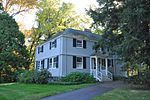H. H. Richardson Historic District of North Easton
Easton, MassachusettsGeography of Bristol County, MassachusettsHistoric districts in Bristol County, MassachusettsHistoric districts on the National Register of Historic Places in MassachusettsNRHP infobox with nocat ... and 6 more
National Historic Landmarks in MassachusettsNational Register of Historic Places in Bristol County, MassachusettsRailroad-related National Historic LandmarksRichardsonian Romanesque architecture in MassachusettsRomanesque Revival architecture in MassachusettsUse mdy dates from August 2023

The H. H. Richardson Historic District of North Easton is a National Historic Landmark District in the village of North Easton in Easton, Massachusetts. It consists of five buildings designed by noted 19th-century architect Henry Hobson Richardson, and The Rockery, a war memorial designed by Frederick Law Olmsted. It was declared a National Historic Landmark in 1987.The landmark district is contained within the larger North Easton Historic District which was added to the National Register of Historic Places on November 3, 1972. It also contains the Old Colony Railroad Station which was individually listed on the NRHP on April 11, 1972.
Excerpt from the Wikipedia article H. H. Richardson Historic District of North Easton (License: CC BY-SA 3.0, Authors, Images).H. H. Richardson Historic District of North Easton
Pond Street,
Geographical coordinates (GPS) Address Nearby Places Show on map
Geographical coordinates (GPS)
| Latitude | Longitude |
|---|---|
| N 42.07 ° | E -71.100555555556 ° |
Address
Pond Street
02356
Massachusetts, United States
Open on Google Maps







